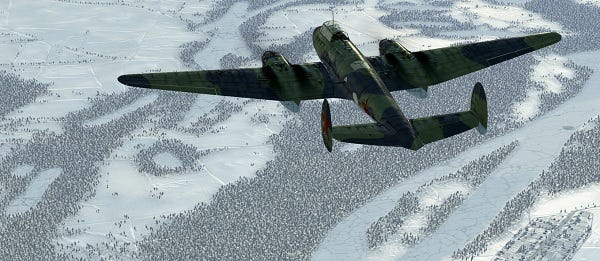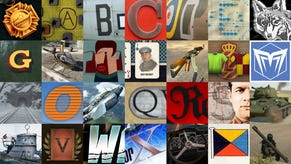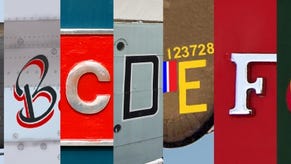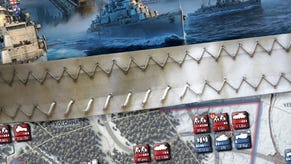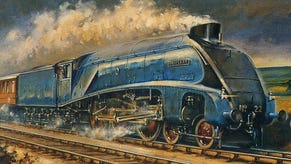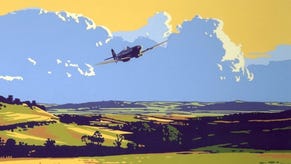Best Of Gamescom: IL-2 Sturmovik And Oculus Rift
A Rift In The Sky
I didn’t believe in the Oculus Rift. Not in the way that I don’t believe in Derek Acorah, the phantom of credibility, but in the way that I don’t believe in matter transporters or eating only one biscuit. The Rift had seemed like an impossible dream, a product of improbable technology and the overly forgiving impressions of excited humans. Now I believe and all it took was a flight over Stalingrad in a Sturmovik.
Almost everyone I knew who had tried the Oculus Rift told me that it was, if not the future, at least a very compelling part of a possible future. They waved their hands as if they were trying to sell me an overpriced heap of a boat, standing, sipping their fizz and muttering to each other like members of an oddly exclusive cult.
“Total immersion,” one of them would occasionally rhubarb to the others, “deliciously complete and absolutely total immersion.” They sounded like they had molasses for gums and could have been talking about bathing in llama milk for all that it mattered to me. If I asked them to explain what made the immersion so absolutely total, they’d splutter into their drinks. “It’s impossible to put it across in words. You have to be there.” Ha! You lousy voyagers of the virtual, I’m not buying what you’re selling.
Except, of course, now that I’ve tried it for myself, I very much AM buying it as soon as it’s available. The Rift works astonishingly well, even when it’s eye-cups are projecting murky, low-res imagery directly into the brain. That said, for all my newfound excitement, I do have my doubts as to which games it will suit and how effective it’ll be in the long-term.
Like so much else, the following words are mostly about cockpits.
My first experience with the Rift was at the Hawken booth at this year’s Gamescom. I didn’t jump into the actual game, just looked around the garage. I adopted a very British approach to virtual reality, barely shifting my head at all but letting out the occasional ‘cor’ or ‘blimey’ when the in-game visual tracked even the slightest movement of my head. I didn’t want to make a fuss, so when the nice man in charge of proceedings asked if I felt like looking over my shoulder, I went along with it.
I’d been fully aware of the people around me, the thousands of them pressed into the convention centre, I’d been aware of the booth’s flimsy walls and the monitor, whose lightshow was now imprinted on my eyeballs. When I adjusted myself in the seat to look behind me, I saw the back of the garage, where bots were being hosed down or steaming quietly. Probably. I don’t remember the details because the sudden realisation that the game world was now all around me knocked me for six.
As I recovered, out at the boundary, I slipped the Rift off and smiled sheepishly. I’d made a strange excited noise at the end there and wanted to be sure that it hadn’t completely punctured my inscrutable veneer. No chance. I was as scrutable as a Roger Scruton primer and everybody in the room was smiling at me as if I’d just performed some kind of magic trick. Developers, in my few short experiences, are delighted by the Oculus Rift, as if it were their own creation. Their excitement at seeing their work delivered in this way is infectious.
Hawken was the appetiser before the main course. It’s fitting that IL-2 Sturmovik, a new expression of a revered classic, should be my first real introduction to the true future-tech experience.
I sat and I listened, impressed by the scope and the ambition of the team, as Sturmovik was described, with slides, videos and photographs. I’ll briefly cover some of the things I was shown. Bear in mind that I didn’t know about the Rift integration until I was taken into the next room. I thought that the slideshow and talk was the extent of the presentation. Now, it’s little more than a footnote.
Sturmovik can, the developer confidently states, be used as a training program for pilots. It is an authentic simulation, going so far as to use recently declassified files in order to recreate the machines that fought in the skies above Stalingrad. Ten planes have been modelled, with soft body physics allowing them to break apart realistically as the stresses of flight, combat and impact take their toll. The development team build them as if they were engineers, constructing each part and then attaching it as if making a real vehicle.
The terrain covered is enormous – I’ve written 118x103 (?) in my notepad – with the city itself a gray puddle in a much wider landscape. Across that vast area, missions are generated dynamically, with unique objectives every time, in both single and multiplayer. Servers support up to one hundred players at a time but even the fight against AI is promising – no special physics are gifted to the computer, allowing it to cheat the system. It flies as a player does, which allows it to make the same mistakes and to battle against the unpredictability of the simulation.
All of that sounds good but it’s no more than talk until we get to see more of the game. More than talk is how impressive Sturmovik already looks. Individual buildings are recognisable, recreated from period photography. The city is dense and believable, and vehicles are extremely detailed, including the planes themselves, and their cockpits.
Yes, the cockpits. I was still thinking about the brief Hawken experience as I watched and interrupted the presentation: “Are you thinking about Oculus Rift integration?”
For the second time that day, everybody in the room was smiling.
The setup was in the next room, a cupboard really, with the Rift set to one side and a screen set up with the game running. Chief Producer Albert Zhiltcov entered the room with me, practically dancing with
enthusiasm, and told me to put on the headset.
I felt like a professional now, a veteran following one previous field mission. They wouldn’t have to tell me, panto-style, to look behind myself this time. I was ready to play it cool and to have a little more fun.
Zhiltcov told me that he’d take the stick himself, which was something of a relief. I like flight sims but it takes me forty minutes to be comfortable with the controls before I’m even ready to take off. I’m not the most confident pilot.
To be a passenger, flying over Stalingrad, is perhaps the most peaceful experience I’ve ever experienced in a game. There was no combat – presumably because the game is still in the early stages of development – just the scenery and the plane. The instruments are right there, close enough to touch. The stick moves in synch with the pilot’s instructions and the glass coverings over dials and read-outs catch the sun as we turn, tipping a wing toward the sky. I look up and to the right, following the line of the wing as it touches a cloud. The clouds are three dimensional shapes – they’re probably volumetric, but I don’t really know what that means – and the metal makes a vague impression on the shape as it passes through. It’s extraordinary to see. It would be even if it were on a screen but on the Rift, where it seems like a physical thing in close proximity, it’s awe-inspiring.
Not explosions, not the intensity of combat or a parkour chase – clouds. The sky, the land beneath. When I turn in the other direction I’m looking right at Zhiltcov, who I no longer acknowledge except as a voice, responding to my requests even as he points out every interesting sight between our plane and the horizon. As we turn, the view to the left is of the ground, a bleak landscape, made more so by the low resolution grime of the image.
It doesn’t bother me, that technical imperfection. It’d be like complaining about the resolution of stained glass. A truly spectacular sight does not necessarily rely on fidelity and cleanliness to convey its effect. I’m more impressed by this than the sights from my window on the flight to Cologne. The view is less constricted, the altitude is lower and the pilot is willing to take risks.
When our wingmen come into view, they are specks in the distance. We accelerate, the sound of the engine more present than before I donned the Rift. When we catch them, I look up at the belly of one fighter, craning my neck to keep it in view as we overtake. The other flies alongside us. I can see the pilot. And then, without warning, Zhiltcov hits the ejector button.
The sound cuts out, replaced by the (hopefully not) ragged flap of canvas and the gentle rush of wind. When I look up, I can see the parachute above me, the cables that hold me in place. Below, the world seems like waves, gently swaying and ready to welcome me back. I scan the skies, hoping to see my plane as it prepares to end, but I’ve already missed it, or perhaps looked in the wrong direction.
I removed the Rift before I hit the ground and talked with Zhiltcov about the technology, how difficult it has been to implement (not very) and how excited he is by the possibilities. We talk about that more than we talk about the game, which is a shame in some ways, but unavoidable. It was the highlight of my Gamescom, by some distance, and I’ve been trying to put it into words ever since.
When the player is in a moving object but his/her body is not actually in motion within that body, the Rift appears to translate brilliantly. Using it in a first-person shooter, where the motion of the avatar body would be necessarily refuted by the player’s own means of control over it, seems odd. The Rift simulates the movement of a head, nothing else, so it is an ideal fit for games with cockpits. I’m not joking even slightly when I say that I want Euro Truck Simulator 2 implementation right now.
It’s the ideal tool for tourism and, using it as I did, with another player at the controls, seems a wonderful way to share games. It’s a passenger device as much as a pilot device. I want to look at Panoramic photographs using it and to wander Street View. More than anything, I want to fly again. It helps that Sturmovik is shaping up to be such an ambitious game, but I think I’d be almost as happy in another flight sim, something older and more rusted.
Whether it’s trains, planes or automobiles that they spend their time in, the Oculus Rift is destined to be a favourite tool of simulation advocates. Next, I want to take it into space.
